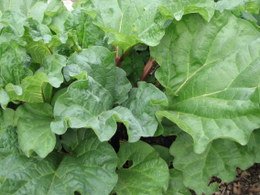Rhubarb Growing Guide
Rhubarb (Rheum rhabarbarum) is a perennial and will be in the location you choose for a long time. It is hardy in USDA zones 3 to 8.
You may want to set aside a nice sunny area of your garden for some perennials such as rhubarb, blueberries, and horseradish, because they prefer a slightly acid soil and make good companion plants.
It does best in full sun, but can tolerate some light shade. It will grow 2 to 3-feet high and spread 3 to 4-feet wide.
It is very easy to grow and requires very little care. Stalk color can be red, pink or green, with red being the most popular.
It is also deer resistant and can be located anywhere that there is enough sunlight. It would also make an interesting foliage plant in your flower garden.
Soil Preparation
The soil should be nice loose well drained organic garden soil with the soil pH between 5.5 to 6.5. As soon as the soil is frost-free and can be worked, till the soil by digging down 8 to 12-inches turning the soil over with a garden fork. Remove any large rocks and stones. The small stones remaining will do no harm and actually benefit the soil by adding some micro-nutrients to the soil.
Planting Rhubarb
Rhubarb varieties are hybrids and do not stay true from seed. Rhubarb is propagated by division. You can purchase the crowns or obtain one from a fellow gardener.
The dormant crowns should have at least 1-strong bud. Dig a hole at least wide enough for the roots and deep enough so that the bud is 2 to 3-inches deep. Plant your rhubarb divisions 2 to 3-feet apart.
Let your plant get established the first year and begin a light harvest the second year.
Dividing Your Plants
After 5 to 6-years the stalks begin to get smaller, because the crown gets too crowded. When this happens start dividing the crowns 1 or 2-at a time to allow the new plants to get established.
Doing the divisions helps to rejuvenate the plant. To help prevent the spread of disease you should disinfect your garden tools and knife with a 10% bleach solution.
In the early spring about 4 to 6-weeks before the last frost date occurs and before growth begins, you can divide the clump into many sections.
Some gardeners will use a knife or a shovel to slice off a portion of the plant. A better way is to dig up the entire plant. Now you can see what you have. If you wash the soil off of the roots the entire root structure can be seen.
Examine the root ball for the eyes or growing buds and carefully try to break it apart with your hands and then tease the roots apart using a knife if necessary. In many cases the root ball will easily break apart into many sections.
You will now have more new plants that are identical to each other to replant or give away.
Watering and Care
When the leaves are a few inches tall add a nice loose mulch of shredded leaves or pine straw to shade the plant roots. This will keep the weeds out, the soil cooler and help retain moisture. Keep the mulch a couple of inches away from the stem. During dry spells give some water each week.
During the growing season the oldest and lower leaves will shrivel up and die. Remove those and toss out.
Fertilizing
In the early spring just as growth appears, you can feed with an organic balanced vegetable garden fertilizer such as Espoma Garden-tone.
Just scratch it into the soil in a circle around the emerging leaves.
Harvesting Rhubarb
You harvest the rhubarb by simply taking hold of the stalk down near the base and pulling and twisting it free. The leaves have a high amount of oxalic acid, which makes them inedible. Cut the leaf off of the stalk and add it to your compost pile.
Diseases and Pests
Rhubarb is usually trouble free. Fungal leaf spot may occur if the leaves continually get wet. When watering, water at the base early in the day to allow the leaves to dry. If the plants are too crowded you can move them next spring.
A couple of pests that may occur are slugs, rhubarb curculio and the potato stem borer. Handpicking is the best method to control them.
Discard any diseased or dead leaves during the growing season and do a good clean up after the frost kills the leaves in the fall.
Popular Varieties
Some popular varieties are: Canada Red, Crimson Red, MacDonald and Victoria.
Sources: Seeds Now, Burpee, Gurney's Seed and Nursery
Tips and Warnings
Discard the inedible leaves and let the plant get established before harvesting the second year.
During the summer a seed stalk may appear that could reach 4 to 6-feet high. This takes a lot of energy from the plant and should be removed as soon as it appears.
Garden Spikes newsletters give you timely information once or twice a month. Subscribe Free to the Garden Times newsletter below.
Your email address will only be used to send you a newsletter and will never be sold. You can unsubscribe at any time.

